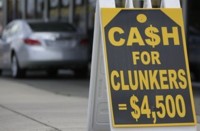Cash-for-Clunkers -- Did it really Work?

The popular but short-lived US
“Cash for Clunkers” program - hailed by some as a great
success - may not have been effective in achieving its longer term
economic and environmental goals.
class=”MsoNormal”>
class=”MsoNormal”>Researchers at Duke University studied the
effects of the program on vehicle sales, job creation, and
environmental impacts and concluded the program did increase new
car sales and did bump up jobs in the auto and related sectors, but
only by pulling demand forward by a few months.
class=”MsoNormal”>In terms of its environmental impact, the
program may have helped to lower gasoline consumption and
greenhouse gas emissions, but at a very high price.
class=”MsoNormal”>
class=”MsoNormal”>Using Canada as the control group, they
found that the program increased new car sales by about 400,000
units during the July-August period of 2009, while lowering net
vehicle sales to about 250,000 units from June to December in the
same year, in effect shifting vehicle purchase demand forward from
other months.
class=”MsoNormal”>
class=”MsoNormal”>The program created 3,676 job-years of
employment in the auto assembly and parts industries in June to
December 2009, again by shifting jobs forward by only a few
months.
class=”MsoNormal”>
class=”MsoNormal”>However the costs of reducing gasoline
consumption and CO2 emissions were quite high. The researchers best
case scenario suggests a cost of over $91 in government payments
for each ton of CO2 avoided and almost 90 cents for each gallon of
gasoline consumption.
class=”MsoNormal”>
class=”MsoNormal”>On the program’s double objective of stimulating
the purchase of new vehicles and scrapping used vehicles, the
researchers questioned whether two parallel programs, each
targeting one of these two goals, might not have worked better.
class=”MsoNormal”>
class=”MsoNormal”>They suggest a better way to stimulate the
economy would be to provide rebates on new vehicle purchases, but
not require that used vehicles be turned-in for dismantling. This
would pull sales forward from further in the future, providing
longer term economic impacts.
class=”MsoNormal”>
class=”MsoNormal”>A second program aimed at reducing old gas
guzzlers on the road would provide a rebate to consumers who
recycled old, fuel-inefficient vehicles, they suggest. This would
provide greater incentives over a longer term for improving fuel
economy than the “Cash for Clunkers”
program.
class=”MsoNormal”>
class=”MsoNormal”>In summary, the researchers suggest that two
separate programs would have broader participation and would be
more effective in simultaneously providing an economic stimulus and
beneficial environmental impacts.
class=”MsoNormal”>The research paper, “
“Cash-for-Clunkers”: Program Effect on Auto Sales, Jobs and the
Environment” by
Shanjun Li, Joshua Linn, Elisheba Spiller,
is available for download.
class=”MsoNormal”>
class=”MsoNormal”>
class=”MsoNormal”>
class=”MsoNormal”>J.D. Power and Associates has cut its U.S.
auto sales forecasts for the remainder of 2010 and 2011. Cautious
consumer spending, due in part to the lingering high unemployment
rate, is a key reason cited, said Jeff Schuster, director of global
forecasting for J.D. Power, in a
target=”_blank”>Reuters article.
On a seasonally adjusted basis,
annual rates of light vehicle purchases have declined to 11.8
million units in 2010 from 14.1 million a year earlier when August
sales were boosted by “Cash for Clunkers”
incentives the analysis notes.
Source: www.rff.org

